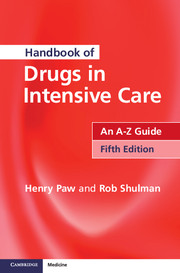Book contents
V
Published online by Cambridge University Press: 05 November 2014
Summary
VANCOMYCIN (Vancocin)
This glycopeptide antibiotic has bactericidal activity against aerobic and anaerobic Gram +ve bacteria, including MRSA. It is only bacteriostatic for most enterococci. It is used for therapy of Clostridium difficile-associated diarrhoea unresponsive to metronidazole, for which it has to be given by mouth. It is not significantly absorbed from the gut.
Serum level monitoring is required to ensure therapeutic levels are achieved and to limit toxicity. Successful treatment of MRSA infections requires levels above the traditionally recommended range. Under-dosing and problems associated with the sampling and the timing of serum level monitoring are problems that may result in decreased efficacy of vancomycin in the treatment of infection. The efficacy of vancomycin depends on the time for which the serum level exceeds the MIC (minimum inhibitory concentration) for the micro-organism rather than the attainment of high peak levels. Administration of vancomycin as a continuous IV infusion is therefore an ideal method of administration for optimum efficacy. Once the infusion reaches a steady state, the timing for serum level monitoring is not crucial, and samples can be taken at any time.
Vancomycin-resistant strains of enterococcus (VRE) are well recognised in the UK. Resistance also occurs less commonly in coagulase-negative staphylococci and is starting to emerge in rare isolates of Staphylococcus aureus.
- Type
- Chapter
- Information
- Handbook of Drugs in Intensive CareAn A-Z Guide, pp. 229 - 240Publisher: Cambridge University PressPrint publication year: 2014



